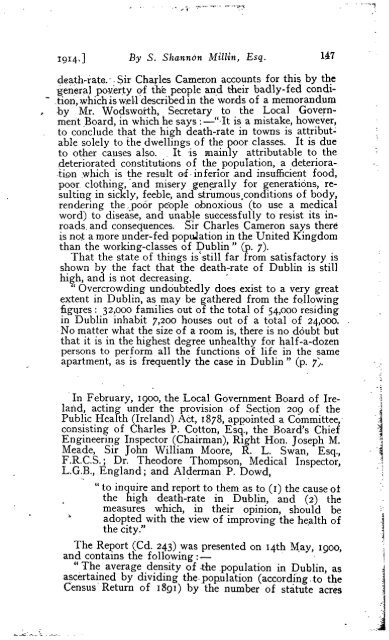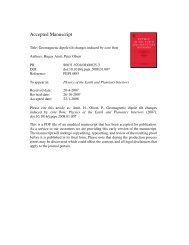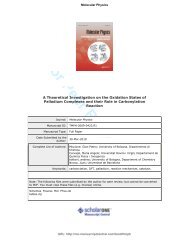Read Friday, 23rd January, 1914. - TARA - Trinity College Dublin
Read Friday, 23rd January, 1914. - TARA - Trinity College Dublin
Read Friday, 23rd January, 1914. - TARA - Trinity College Dublin
Create successful ePaper yourself
Turn your PDF publications into a flip-book with our unique Google optimized e-Paper software.
<strong>1914.</strong>] By S. Shannon Millin, Esq. U?<br />
death-rate. • Sir Charles Cameron accounts for this by the<br />
general poverty of the people and their badly-fed condition,<br />
which is well described in the words of a memorandum<br />
by Mr. Wodswoxth, Secretary to the Local Government<br />
Board, in which he says : —"It is a mistake, however,<br />
to conclude that the high death-rate in towns is attributable<br />
solely to the dwellings of the poor classes. It is due<br />
to other causes also. . It is mainly attributable to the<br />
deteriorated constitutions of the population, a deterioration<br />
.which is the result of inferior .and insufficient food,<br />
poor clothing, and misery generally for generations, resulting<br />
in sickly, feeble, and strumous.conditions of body,<br />
rendering the,poor people obnoxious (to use a medical<br />
word) to disease, and unable successfully to resist its inroads,<br />
and consequences. Sir Charles Cameron says ther€i<br />
is no.t a more under-fed population in the United Kingdom<br />
than the working-classes of <strong>Dublin</strong> " (p. 7).<br />
That the state of things is still far from satisfactory is<br />
shown by the fact that the death-rate of <strong>Dublin</strong> is still<br />
high, and is riot decreasing.<br />
" Overcrowding undoubtedly does exist to a very great<br />
extent in <strong>Dublin</strong>, as may be gathered from the following<br />
figures : 32,000 families out of the total of 54,000 residing<br />
in <strong>Dublin</strong> inhabit 7,200 houses out of a total of 24,000.<br />
No matter what the size of a room is, there is no doubt but<br />
that it is in the highest degree unhealthy for half-a-dozen<br />
persons to perform all the functions of life in the same<br />
apartment, as is frequently the case in <strong>Dublin</strong> " (p. 7).<br />
In February, 1900, the Local Government Board of Ireland,<br />
acting under the provision of Section 209 of the<br />
Public Health (Ireland) Act, 1878, appointed a Committee,<br />
consisting of Charles P. Cotton, Esq., the Board's Chief<br />
Engineering Inspector (Chairman), Right Hon. Joseph M.<br />
Meade, Sir John William Moore, R. L. Swan, Esq.,<br />
F.R.C.S.; Dr. Theodore Thompson, Medical Inspector,<br />
L.G.B., England; and Alderman P. Dowd,<br />
" to inquire and report to them as to (1) the cause ot<br />
the high death-rate in <strong>Dublin</strong>, and (2) the<br />
measures which, in their opinion, should be<br />
* adopted with the view of improving the health of<br />
the city."<br />
The Report (Cd. 243) was presented on 14th May, 1900,<br />
and contains the following: —<br />
" The average density of the population in <strong>Dublin</strong>, as<br />
ascertained by dividing the-population (according.to the<br />
Census Return of 1891) by the number of statute acres
















